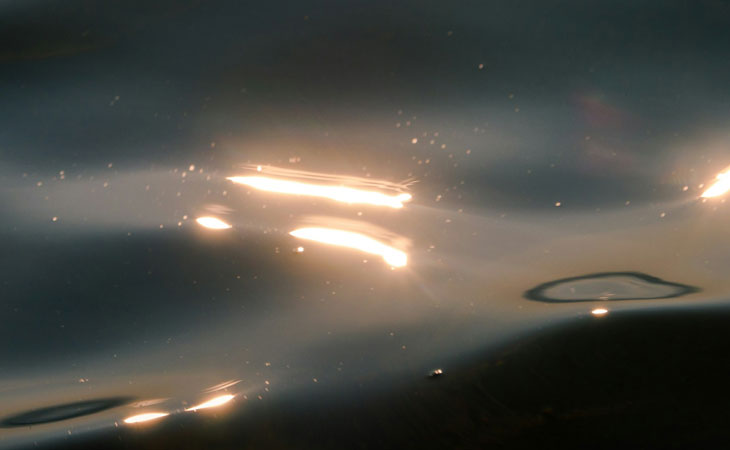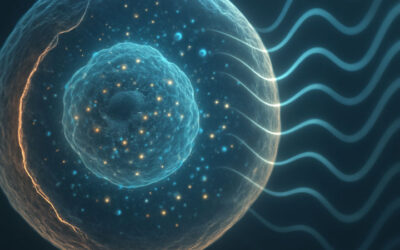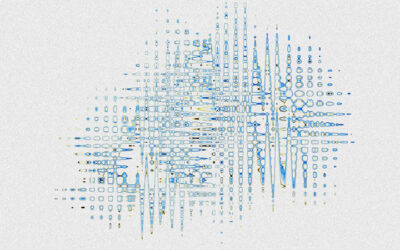If you send a loud enough tone into a liquid, tiny gas bubbles can implode so violently that they flash with light. This is called sonoluminescence. In its cleanest laboratory form, a single micron-scale bubble sits in a standing acoustic wave and emits a picosecond-long gleam at each collapse. That’s a candle-flicker measured in trillionths of a second. The effect is real, repeatable, and still partly mysterious. [1]
What actually happens inside the “star in a jar”?
In simple terms, sonoluminescence shows how sound energy can focus into light. A sound wave makes a bubble expand and contract again and again. When it collapses, the compression becomes so extreme that the gas inside heats up to thousands of degrees. Some experiments even suggest that the bubble forms a tiny plasma, a hot, glowing state of matter.
The light flashes are extremely short, just picoseconds long (a millionth of a millionth of a second). The bubble is no bigger than a micrometre, yet inside it may reach temperatures as hot as the surface of the Sun. [1]
A few things influence how bright the flash is:
- The gas inside: Noble gases like argon or xenon make the light brighter. [2]
- The liquid around it: Water, acids, and impurities change the effect.
- The sound field: The frequency, strength, and shape of the container decide if the bubble is stable enough to glow.
Despite decades of study, scientists still don’t fully agree on all the details, whether the light comes mainly from plasma radiation, shock waves, or other processes. But what’s clear is that sound can create extreme conditions that lead to light.
A few more details
The effect was first noticed in 1934, when German researchers saw that high-frequency sound made bubbles flash in water. For many years it remained a curiosity, until the 1990s, when scientists learned to trap a single bubble steadily in place, thus allowing sonoluminescence to be studied with precision. [3]
Beyond its beauty, sonoluminescence helps scientists understand how energy focuses in fluids and plasmas. It connects to real-world fields like: Sonochemistry (using sound to speed up reactions), Medical ultrasound (understanding how sound interacts with tissues) and Materials science (using bubbles for cleaning or processing surfaces). [4]
Let there be light!
The line “Let there be light” (Genesis 1:3) is usually read as God’s first creative act, the moment when order begins to emerge out of chaos. If we look at it through the lens of sound and vibration, God speaks light into existence. Creation begins not with a physical gesture, but with a vibration expressed as voice.
In many mystical traditions, the spoken word (or primordial sound) is not just a metaphor but the actual engine of creation. For example:
-
In the Gospel of John, we read “In the beginning was the Word, and the Word was with God, and the Word was God”. Here, sound/word (Greek Logos) is presented as the principle from which all things flow. I tend to resonate more with the interpretation of the word Logos as Intellect. However, the most common translation as “word” makes it relevant for this topic.
-
The Vedic Om is seen as the seed sound from which the cosmos unfolds.
-
In Kabbalistic thought, creation itself is shaped through divine speech, letters, vibrations, and names.
Sonoluminescence, of course, doesn’t substantiate any of this. But it does offer a striking image:
Acoustic fields can focus energy so intensely that light is emitted (on ultrafast timescales from micron-scale cavities). That fact alone is wondrous, and it’s tempting to stretch the bubble into a cosmology.
So let’s indulge in a stretch of imagination that may not be that far out.
After all, the number of ancient traditions that relate the creation of the world/universe to an acoustic event is quite striking.

Sound as a Creative Force in World Mythologies
Sound as a Primal Creative Force
In many cultures sound itself is the decisive act of creation. The primordial void is often imagined as silent until a first sound breaks the emptiness, a vibration that brings matter and order into being [5].
Aboriginal Australia: Singing the World Alive
In Aboriginal Dreamtime traditions, ancestor beings travelled a featureless land and sang each landmark, plant, and animal into existence. These songs, known as songlines, are not symbolic, they are believed to be the reason the land exists as it does [6]. One account says: “through their thoughts, dreams and journeys [the Ancestors] sang the world into existence” [7].
Polynesia: Sound as the First Act
A Māori cosmogonic chant describes the silence of the void turning into sound, and that sound creating heaven and earth [8]. In Tahiti, the creator god Taaroa was said to have formed himself inside a resonating conch shell, the sound chamber of the cosmos, before shaping the world [5]. In Tonga, a great rock split apart with a thunderous noise, giving birth to the first beings [9].
Africa: Drums, Thunder, and the Creator’s Snap
African cosmologies often link creation to thunder, drums, or other natural sounds. The Maasai identify distant thunder as the good voice of the creator [9]. A West African story says the world began when the creator snapped his fingers, the sharp crack becoming the first act of creation [6]. Among the Kamba of Kenya, the word for the creator, Mulungu, also means “flute,” implying the creator is musical sound itself [5]. Some Central and Southern African peoples speak of talking trees whose booming resonance was the drum of creation [5].
North America: Thunder, Flutes, and Wingbeats
Among the Cheyenne and Arapaho, the Great Spirit shaped the world with a mighty voice of thunder [9]. In an Arapaho story, the Creator walked over the waters with a sacred flute; on the seventh day he coughed and cried out, and land appeared. As he played his flute, the earth solidified [10]. The Yuki of California tell that the deity Taikomol emanated a great chant, its vibrations causing dry land to rise [10]. Other Californian tribes describe the clap of the Creator’s hands or the bullroarer’s rumble as the sound that brought forth the cosmos [10]. In one Wintun tale, a lamprey eel blew through its holes like a flute, and its droning whistle shaped the world [11]. In Inuit myth, Raven flapped his wings, and the beating sound stirred the ocean, forming land [10].
South America: The Universe as Sound
The Uitoto of the Colombian Amazon say that “in the beginning, the Word gave origin to the Father”, the creator god himself emerged from vibration [12]. Their myths describe the creator using breath and saliva to sound the world into form [12]. Some analyses interpret the creator’s body as a cosmic drum [1]. Across the Amazon, sacred flutes and trumpets are often portrayed as primordial instruments of creation, and in Tupi-Guaraní traditions, the first woman saved the world by singing a sacred melody that restored balance [13].
Eurasia: Cosmic Vibrations and Sacred Sound
In India, the Vedas describe the universe beginning with sound (Nāda Brahma), expressed in the syllable Om [5]. Prajāpati, the creator, is said to have been born from sound-breath and to have sung the world into existence [5]. Later mythology personifies this in Shiva’s drum (damaru), whose rhythm drives cosmic creation and dissolution. In Egypt, the god Thoth was said to have clapped and laughed the world into being, each peal of laughter birthing gods and elements [10]. In Mesopotamia, Enki’s creative word was likened to a drumbeat [5]. Chinese traditions describe the first thunderclap as the signal of creation, sometimes called the “laughter of the clouds” [9]. In Japan’s Nihon Shoki, a deity emerges from a heavenly reed instrument, linking creation directly with music [10]. In the Hebrew Bible / Early Christianity, the Genesis frames creation as a sequence of divine speech—“And God said, ‘Let there be light’”—while John’s Gospel universalises this as the Logos, “through whom all things were made” [14]. In Islam (Qur’an), Creation is by divine command: “Be! and it is” (kun fa-yakūn), a terse formula of reality arising through utterance [15].
From Macrocosm to Microcosm: the Alchemy of Sound
If we want to stretch the “bubble” even further beyond Cosmology and into personal practice, we can conjure the following analogies:
- Resonance and timing matter. In the lab, a bubble flashes only when the drive and phase are just right. In personal practice, consider how breath, rhythm, and attention align before expecting coherent effects.
- The medium conditions the message. Change the gas or liquid, and the light changes. Likewise, physiology (nervous system state, hydration, electrolyte balance) and environment (room acoustics, intention) shift our response to sound.
- Energy focuses via gradients. Sonoluminescence concentrates energy through steep pressure and temperature gradients. There is a similarity to the Alchemical imagery of the elements transformed by fire in a crucible. One such practice that works with alchemical principles is Sat-Sound™ Alchemy of the Voice, which sharpens perception and catalyses insight.
Conclusion
Sound in many forms (song, thunder, breath, drum, flute, wingbeat) appears as the primal spark of creation. These myths remind us that across cultures, people intuited what physics also hints at: before light, form, and life, there was vibration. From that vibration, the cosmos took shape.
Sonoluminescence reminds us that science and mystery can meet. It’s both a physical fact and a symbol, an image of how vibration, under the right conditions, becomes illumination.
- References
- https://journals.aps.org/rmp/abstract/10.1103/RevModPhys.74.425
- https://suslick.scs.illinois.edu/documents/prl0544301.pdf
- https://pubs.aip.org/physicstoday/article-abstract/47/9/22/408114/SonoluminescenceA-simple-mechanical-system-can?redirectedFrom=fulltext&utm
- https://www.annualreviews.org/content/journals/10.1146/annurev.fluid.32.1.445
- Schneider, Marius. Primitive Music: An Inquiry into the Origin and Development of Music. (1969).
- Chatwin, Bruce. The Songlines. Jonathan Cape, 1987; supported by Australian Museum resources.
- Aboriginal Dreamtime account cited in: Australian Government, National Museum of Australia – Dreaming narratives.
- Biggs, Bruce. The Maori As He Was: A Brief Account of Life as it Was in Pre-European Days. Polynesian Society, 1924.
- Eliade, Mircea. Patterns in Comparative Religion. Sheed & Ward, 1958.
- Leeming, David. Creation Myths of the World: An Encyclopedia. ABC-CLIO, 2010.
- Kroeber, Alfred L. Indian Myths of South Central California. University of California Publications, 1907.
- Preuss, Konrad. Religion and Myth of the Uitoto Indians of Colombia. (Translated ethnographic work).
- Lévi-Strauss, Claude. The Raw and the Cooked. Harper & Row, 1969.
- Budge, E.A. Wallis. The Gods of the Egyptians. Dover Publications, 1969.
- The Holy Bible, Genesis 1:3; John 1:1–3 (various translations; see BibleGateway.com).
- The Qur’an, e.g., Surah 2:117; Surah 36:82. (Quran.com translations).
Check our other articles
Can Cells Really Hear?
Those of us working with sound in a therapeutic setting have been well aware of its profound impact on the human body. We know that sound can calm the nervous system, shift our emotions, and bring us into states of deep presence. Yet, the general view of sound is that...
Soundscape Mapping: Tuning Into the Subtleties of Your Sonic Environment
Mostly, we think of sound healing as something we create, an intentional experience shaped by voice and instruments. A moment set apart from the noise of the world, a carefully curated bath of vibration and stillness. But what about the sounds of daily life, where we...
Sound Therapy and Neurodivergence
The Resonant Power of Sound Healing for Neurodivergent Individuals In a world filled with sensory stimuli, neurodivergent individuals, such as those with autism spectrum disorder (ASD) or attention-deficit/hyperactivity disorder (ADHD), often experience heightened...



